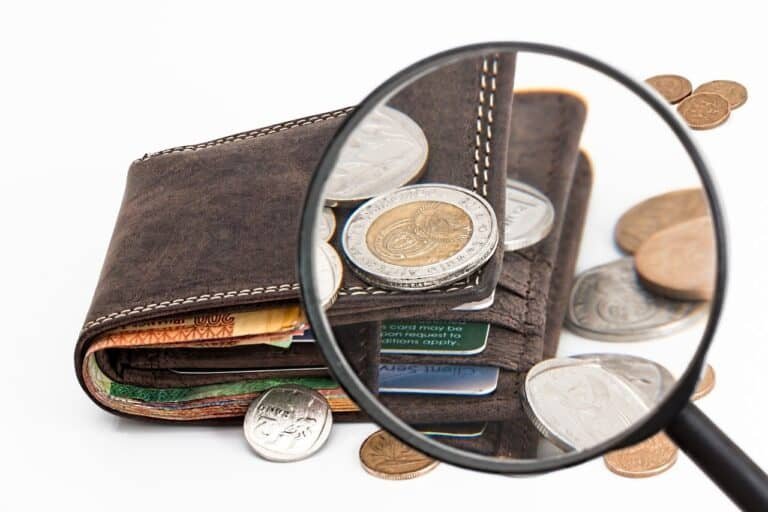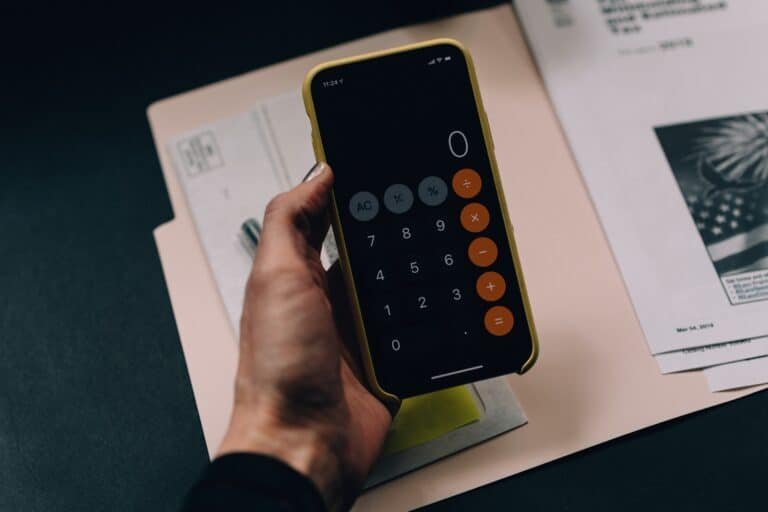How to Save Money on Groceries
Ever gone to the grocery store and later came back with items you hadn’t planned to buy? It happens more times than some of us can count. But it’s possible to change this overspending habit if you learn how to save money on groceries.
You can do grocery shopping on a budget and still eat healthily. Cutting your grocery bill is a great chance to improve your financial health. The extra money can be put toward savings, investments, and debt payoff.
This article is reader-supported and contains affiliate links. We get a small commission for specific actions or purchases made through them. Read more on the disclaimer page.
How Much Should You Spend on Groceries a Week?
According to financial expert Dave Ramsey, it’s good to spend 10-15 percent of your take-home pay on food. That’s roughly 4 percent of your net monthly income going into groceries, dining out, plus any other food expenses each week.
Let’s say you earn $2,000 per month and have chosen to spend 10 percent on food. Only $200 should go into your monthly food expenses or $50 if it’s weekly.
23 Ways to Save Money on Groceries
No more filling your basket with unnecessary items when doing grocery shopping. This article is going to show you how.
Here are 23 ways to spend less money on groceries.
1. Meal planning.
This is all about planning what you’ll eat each day of the week in advance. You won’t have to think about what’s for dinner every night.
Many people think that meal planning is only for sizeable families. But it’s good to practice it even if you’re staying alone. There are many recipes for one person online to try out while on a budget.
In meal planning, you choose your dinners, shop for the groceries you need, and prepare them. Remember to only include the days you’ll be cooking at home.
You can plan your meals during the weekend when not busy. And you’re free to revisit your meal plan any time to make it better.
While you’re allowed to order out on some nights, meal planning is perfect for cutting back on expensive food takeouts. It gives you a chance to save money, eat healthy meals, and not waste food.
Want to make planning your meals simple and effective? $5 Meal Plan is a meal planning service that can save you time and money. You get meal plans sent to you by joining their affordable service.
Check out the $5 Meal Plan 14-day trial
2. Go meatless.
Meat is a significant part of meals for many people. But it’s possible to have a meat-free diet and live life as usual. In fact, you may enjoy some health benefits too.
A study by the Journal of Hunger and Environmental Nutrition found that going meatless could save you around $750 per year. Depending on how much you need to save on grocery shopping, you can avoid meat for a week, month, or longer period.
Keep in mind that you don’t have to give it all up straight away or forever. Start by getting rid of one meat dish at a time to make the transition smoother. You can even save specific meat-based recipes only for special occasions.
When going meatless, it’s best to try some new dishes. These could be the things you never tried because you’ve always had meat on your plate. Doing so takes your mind off anything to do with meat and the shift won’t be hard on you.
3. Find recipes for the available ingredients.
You shouldn’t leave specific ingredients to go bad because of not using them. Neither do you have to go to the grocery store for more stuff while you’re on a budget.
The number of dishes to prepare using the ingredients you already have might surprise you. And there are many recipe websites to check out.
One such site is Supercook. You only need to select all the things you have under categories like dairy, vegetables, fruits, and more. There’s even a microphone feature that allows you to only speak out what’s in your fridge or pantry.
The site will show recipe suggestions as you add new items. You’ll also see additional ingredients needed for a particular dish.
4. Create a grocery list and stick to it.
A grocery list comes in handy when shopping for groceries on a budget. It ensures that nothing required is left out. Better yet, it helps you not to buy anything you don’t need.
It’s good to prepare the grocery list a few days before going to the grocery store. Having more time to make applicable changes is essential for an effective list.
Include the units you need for each grocery. Besides saving you money, only buying a specific quantity keeps you from going to the stores every day. So, there’ll be fewer spending temptations.
Unless it’s your first time shopping at a store, you probably know where each item is placed. It’s good to organize the list such that you won’t have to move back and forth when picking up different groceries.
This way, you spend little time shopping. The result is little to no instances of impulse buying.
If you need instructional videos and printables on creating a shopping list, recipes, and other grocery tips, check out the Grocery Budget Makeover. It’ll make grocery shopping much easier for you!
5. Use cash-back apps.
Want to know how to save money on groceries by using your phone? There are several apps that offer rewards for shopping online or in-store.
Ibotta is an example of a cash-back app that pays you for grocery purchases.
Here’s how the app works:
- Download the app: Create an account through your phone.
- Choose an offer: Find items on Ibotta that are also on your grocery list. You’ll see tasks you need to complete before getting the cash back. These include taking part in polls, watching videos, and writing brief reviews.
- Buy the items: You have to make a purchase from a store that’s supported by Ibotta. Some offers require a specific store.
- Show proof of purchase: Once you’ve bought items, click “Redeem” on Ibotta. Select the store you purchased from and upload a photo of your receipt.
- Get paid: Ibotta gives you cash back when they confirm your purchase. You’ll need at least $20 to cash out.
Another option to confirm your purchase is to link your loyalty card to Ibotta. Also, you can shop through the app and earn the rewards automatically.
Shopping at Tada is another great cashback opportunity on grocery purchases. The app works with many stores, including your favorite ones.
6. Know the items on sale.
It helps if you know what’s on sale each time you’re planning to go grocery shopping. You get a chance to spend less money on groceries.
Visit a specific grocery store’s website to find out if there’s a discounted item you need. Stores with social media pages also post such information there. Another option would be to check out billboards, sale flyers, and other print ads.
You might notice some trends and have an idea of which time of the year different groceries go on sale. Wouldn’t it feel great to be among the first people to grab such discounts?
7. Eat before grocery shopping.
If you want to be more tempted to buy items you don’t need, go to the grocery store while hungry. Your body will tell you to fill up a shopping cart with anything that looks tasty.
Even if the grocery bill is high, you’ll most likely pay it without second thoughts. But you may regret the decision later on when you’ve left the store and fixed your small “hunger” problem.
The best way to keep away from impulse food purchases is by going grocery shopping after eating something. Having a snack or two before entering the store can be helpful. But it’s much better if you only go there after a meal.
8. Don’t go shopping with overspenders.
Sometimes, it’s the people around you that cause you to spend more money. Maybe they’re good at convincing and you want to make them happy.
In most cases, kids have this effect on their parents and older siblings. It’s necessary to go to the grocery store without them if it means you’ll save more money for bigger things. Teaching them about money goes a long way toward making them responsible spenders.
Also, it could be a friend that makes you buy unnecessary stuff. If you’re going shopping for groceries on a budget, it’s a good idea to leave them at home too. There’ll always be time to catch up later.
9. Go for a small basket.
Some grocery stores keep shopping carts and huge baskets near the entrance. But that isn’t reason enough for you to take them. It’s best to find a smaller basket in which the items you’re buying can perfectly fit.
There are several reasons why picking a big cart might be a bad idea. One of them is that you may itch to fill up all the space in the cart. Maybe you wouldn’t want people at the checkout wondering why there are only a few things in it.
So, pick a smaller option or carry the groceries by hand if it’s just an item or two. Don’t let a big basket get between you and your grocery budget!
10. Calculate the grocery bill as you shop.
While you go around adding items to your basket or cart, it’s good to know the total cost at each point. This step can help you reconsider purchasing some high-priced items and find cheaper alternatives.
The calculator on your phone comes in handy here. Most of them have all the basics. If you need advanced features, download a calculator from your app store.
In case you’re good with numbers, you only have to add them up in your head. It would also help if you rounded up the prices.
Count veggies that cost $2.79 as $3. Or a bunch of fruits that go for $3.19 as $3.50.
Doing this is essential for staying under your grocery budget. You avoid any surprises when getting your bill.
11. Look at all the shelves.
Many people only pick the items on eye-level shelves when shopping. This habit may make you miss out on lowering your grocery expenses.
Some grocery stores place their costly items on shelves you can easily see and access. It’s a tactic that can have you spending more money on the things you buy.
It’s good to check the higher and lower shelves too when shopping for groceries. You might find cheaper products or special offers that enable you to put the extra money toward something else.
Keep in mind that this strategy doesn’t apply to all stores and shelves. There are instances where the middle shelf has the best offers. But it’s worth looking at the other shelves to ensure you take advantage of any available discounts.
12. Check best before or expiration dates.
It’s a common habit to only confirm expiration dates after getting back from the stores. At such a point, you can’t do anything about it except try to finish the item before it expires.
But if you look at the best before or expiration date while at the store, you avoid buying things that can’t last long enough before you use them. This approach enables you to save money on groceries because you won’t need to frequently throw them away.
Aside from that, you also enjoy your groceries when they’re still of good quality. And having a healthy diet can save you even more money.
13. Buy unpackaged items.
When you buy a well-packaged fruit, veggie, or another item, part of the price covers packaging. That’s because of the material, labor, and manufacturing processes used. Unpackaged items or those in a dull package usually cost less.
Many big brands like to use fancy packages on their products. This means that you’ll probably spend less money on groceries from generic or store brands.
Any time you go grocery shopping on a budget, compare the prices between packaged and unpackaged items. You might be surprised by how much money you can save each week. Feel free to buy packages separately in case you need them for carrying meals and snacks.
14. Only buy the groceries you need.
If you’re a fan of bulking up, you may want to buy several units of an item to reduce your store trips. But doing this can increase your grocery expenses.
Buying more perishable groceries than you can consume means that they’re likely to go bad before being used. It’s best to ensure that the size is not only suitable but also saves you some money.
Compare prices per unit to know whether buying a particular quantity will result in less cost and wastage over time. If you’re a small family or stay alone, going grocery shopping more frequently than others shouldn’t hurt when it’s a saving strategy.
15. Pay with cash.
Credit cards are perfect for fast and secure payments. You even get rewarded for using them. But they aren’t the best payment option if you’re not a responsible spender.
The reason is that you could get into more debt because you’re spending money that isn’t really yours. And a few late fees plus interest payments might affect your credit score.
That’s why you need to start paying for items with cash. Cash payments help you track your expenses better. If you’re aware of the amount of money at hand, you won’t buy anything you can’t afford at a particular moment.
It’s best to take out cash for groceries weekly and leave your credit cards at home when you go to the store. While it can be a challenging process, you’ll spend less money and avoid debt.
16. Go to different grocery stores.
Everyone has their preference when it comes to grocery shopping. Maybe you like a specific grocery store because you like how they serve customers. So you make it a routine to shop there regularly.
But it’s also good to pay attention to the grocery prices. You might be missing out on better prices by going to the same grocery store every time.
Go shopping at a different store each week to find out whether there are more affordable items elsewhere. You can even compare prices with friends who buy groceries at other shops.
If there are any special deals that can reduce your food expenses, make use of them. Again, don’t buy more than you need because you think the prices will go back up.
17. Do online grocery shopping.
Another tip for grocery shopping on a budget is to order items online. You just have to go to your favorite store’s website. Most of them have an online shopping option.
This approach enables you to avoid going to a physical store. It’s a chance to stay on the budget because you’ll have fewer spending temptations.
The reason is that online shopping doesn’t involve seeing and touching real items. Some people only need to smell delicious food before they decide to abandon their budget.
Also, shopping online gives you a chance to know the total cost before purchase. If you go to a store, there isn’t much room for second thoughts once you’re at the checkout.
In online shopping, you save more money by taking advantage of daily deals, free delivery, and other offers.
In fact, it would be great for you to shop for groceries online through MyPoints and get rewarded for it!
18. Buy online and pick up in-store.
This involves shopping online and then going to the grocery store for your items. If you urgently need groceries and need to save money and time, this option would be great.
Once you choose the items you want, a store associate packs everything and you get notified to pick them up. Most times, there’s a designated store section for collecting these orders.
Some stores even have curbside pickup service. You pick up your groceries without leaving your car.
All you have to do is park your car at a spot near the store and let them know you’ve arrived. An associate will bring the ordered items to you.
These convenient services allow you to avoid high delivery fees when you’re on a tight budget.
19. Eat by the season.
Wondering how to save money on groceries while enjoying fresh food? Eat what’s in season!
There are different seasons during which specific veggies and fruits do well in an area. It helps if you gather such information about your location.
When a particular type of grocery is in high supply, the prices go down. As a result, you’ll have low monthly grocery expenses.
But if you buy produce that isn’t in season, you’re likely to spend more money. That’s because of their low supply in your area. So, suppliers have a harder time getting it from other places, increasing transport and other costs.
Try the Seasonal Food Guide to learn about seasonal foods in the US. You only need to select your state and time of the year to see the available options. If you live somewhere else, a few searches online can go a long way.
20. Store food properly.
Your groceries only last longer if you store them properly. And this can keep your food expenses to a minimum because there’s less waste.
Organize your food storage in such a way that you can easily find what you’re looking for. You don’t want to go to the grocery store to buy an item you still have but it’s stored at the wrong place.
Clean your fridge, cupboards, and any other food storage frequently to ensure there’s no spoiled food or spills that can cause more waste.
If your fridge is faulty, it’s time to repair it. You can even replace it if too old because you’ll save more money in the long run.
21. Use your leftovers.
Throwing away leftovers has always been a habit for some people. But if you’re looking to lower your food budget, avoid doing it. Proper food storage helps keep the leftovers suitable to eat for a longer time.
Start freezing portions of food after cooking and reheat them the next day for eating. Depending on the type of food, it might last more than one day under proper conditions. It’s good to keep cooked food for less than a week.
Another thing to do with leftovers is to use them to prepare another meal. For instance, leftover cooked rice can be fried into a new dish. You just need to look up some recipes for more ideas.
22. Grow your own food.
If you own an unused garden, it’s high time you start growing food on it. You can even grow a single plant such as a tomato in a small space in case there’s no backyard at your place.
It helps to research the plants that do well in your area during specific seasons. Buy the seeds and young plants you’ve decided to grow from a local company or farmer. You also need any supplies the plants require.
Producing fruits, veggies, and herbs enables you to trim and even get rid of your grocery budget. Also, gardening is a profitable hobby to make extra money. You generate income by selling seedlings, organic produce, or products made from it.
23. Bring your own reusable bags.
Bringing your own reusable bag is a simple way to save money on groceries. You won’t have to buy a new bag and clutter your home each time you go grocery shopping.
Some grocery stores offer discounts for bringing a bag. You’re free to inquire about such discounts at your favorite store.
It’s usually just a few cents per bag. While the amount saved might not be much, it contributes to cutting your grocery expenses.
Shopping for Groceries on a Budget Shouldn’t Stress You Out
By now, you’ve probably found one or many opportunities to save money at the grocery store. It’s all about changing some habits and adopting new ones.
Your budget for groceries can be successful if you follow one or two tips on this list. Trying each of them can help you lower your grocery expenses further.







